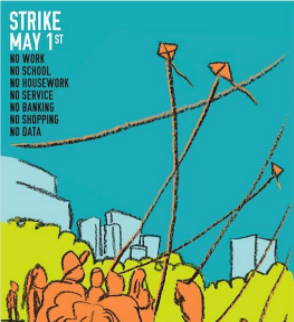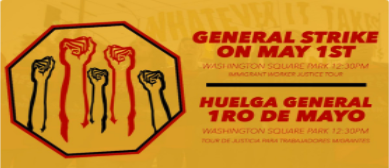By Rob Cook, Flashpoint
The origins of International Workers’ Day, also known as May Day, stem from an 1880s Chicago-based movement by labor unions to force the adoption of eight-hour work days.
May 1, 1886, is considered the first official International Workers’ Day, which included several days of protests, violent clashes with police, and heavy anarchist involvement during the celebration of the new working hours.
An estimated 300,000 workers across the United States participated in strikes on this date.

On May 1, 2017, hundreds of thousands of employees are expected to participate in work strikes across the United States and globally.
Themes of this year’s demonstrations align with pro-immigration, pro-refugee, anti-fascism, anti-racism, anti-Trump, and feminist movements.
The largest demonstrations are expected in Los Angeles, Seattle, Washington D.C., and New York, with smaller gatherings planned in Boston, Chicago, and Miami.
Major supporters of the demonstrations include the Service Employees International Union, United Service Workers West (SEIU USSW) and the Food Chain Workers Alliance (FCWA), which have pledged member support that is estimated at 350,000 workers.
The SEIU USSW represents 40,000 janitors, security officers, and airport and property service workers.
The Food Chain Workers Alliance umbrella encompasses dozens of worker coalitions and unions, representing an estimated 21.5 million employees who “plant, harvest, process, pack, transport, prepare, serve, and sell food” across the United States.
(Boston-area workers share their stories as part of International Workers’ Day. Courtesy of NERCC and YouTube)
Together, the SEIU USSW and the FCWA plan to support various movements’ May Day events, including “Movement for Black Lives, National Domestic Workers Alliance, HEAL Food Alliance, and several West Coast unions in striking for dignified jobs for all.”
Additionally, several groups are planning demonstrations for the ten days prior to May 1, dubbed “Ten days of Resistance.” According to the group Refuse Fascism, the protests leading up to May Day will include:
- April 22: Stand with scientists against the Trump/Pence Regime denying and attacking Science—which is the method by which humanity can understand reality and which is essential to progress.
- April 29: Stand against the Trump/Pence Regime’s Devastation of the Climate and Environment which, without exaggeration, imperils life on earth.

Social media hashtags for May Day activity include:
• #mayday
• #May1Strike
• #globalmaydaystrike
• #shutitdownmay1
• #lahuelga
• #undiasininmigrantes
Assessment
Any sociopolitical event that serves to energize supporters of participating movements may increase the volume of May Day demonstrators, particularly in Los Angeles and New York.

While violence was observed at May Day protests in Seattle in 2011 through 2016, there are presently no indications that this year’s protests will include violent activity.
Flashpoint assesses with moderate confidence that the 2017 May Day activities may impact businesses due to striking workers and walkouts, blockages of business access along march routes, and a general effort to dissuade consumers from making purchases.
The most likely impacts to industry will be related to food service, public transportation (taxis and airport services), and education (teachers).
Original post https://www.flashpoint-intel.com/blog/hactivism/may-day-2017/















